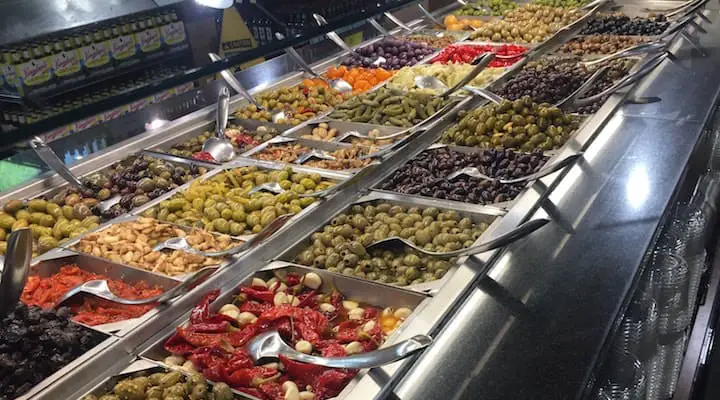
I recently took an in-depth look at the topic of eating olives on a Whole30. I wanted to find out all the common additives in olives and whether each is allowed on the Whole30.
Are Olives OK on Whole30? According to the Whole30 Pantry guide, olives are ok on the Whole30 as long as they don’t include sulfites (Sulfur Dioxide, Sodium Bisulfite, Potassium Metabisulfite, etc). This includes fresh and canned olives and black or green olives.
As you can see the Whole30 guidelines are fairly lenient. We take it a step further and look at which olive brands do and do not contain sulfites and some of the common additives often found in olives, and how to avoid them.
Whole30 Compliant Olives – What to Look For
Olives are one of those foods that often have a lot of hard to pronounce ingredients. This does not mean that olives with very simple ingredients aren’t out there, they are, and we will cover some examples in the following sections.
Let’s start off with what is clearly not allowed to lurk in your olives. The Whole30 additives guide clearly states that all forms of sulfites are “off limits on the Whole30”. Below
You will want to cross check your can/jar/pouch of olives and make sure none of these are listed in the ingredients:
| E number | Sulfite Name |
| E150b | Caustic sulfite caramel |
| E150d | Sulfite ammonia caramel |
| E220 | Sulfur dioxide |
| E221 | Sodium sulfite |
| E222 | Sodium bisulfite (sodium hydrogen sulfite) |
| E223 | Sodium metabisulfite |
| E224 | Potassium metabisulfite |
| E225 | Potassium sulfite |
| E226 | Calcium sulfite |
| E227 | Calcium hydrogen sulfite (preservative) |
| E228 | Potassium hydrogen sulfite |
Table: Sulfites (to avoid on Whole30) – Source: wikipedia
On a more positive note, the Whole30 does allow quite a number of common ingredients found in olives. The following list are common ingredients in olives that are not a problem on the Whole30, and do not rule out your favorite brand of olives.
Common Additives found in Olives Allowed on Whole30:
- Lactic Acid
- Citric Acid
- Ascorbic Acid
- Acetic Acid
- Calcium Chloride
- Ferrous Gluconate
- Natural Flavors
- Sodium Chloride / Salt
- Sodium Nitrate / Sodium Nitrite
- Sodium Alginate
- Guar Gum
- Acacia Gum
- Gellen Gum
- Locust Bean Gum
- Xanthan Gum
- Calcium Carbonate
(source: Whole30 Additives List & Whole30 Basic Grocery Guide)
Other Allowed ingredients sometimes found in Olives:
- Grape Musk
(source: Whole30 Forums)
So the next time you are at the store hoping to try a new brand of olives that sound delicious, just match the ingredient list with the above and you should be able to quickly see if those particular olives are a thumbs up or thumbs down. If not, simply move on to the next one.
Are Black Olives Whole 30 Approved? Even if the Color isn’t Natural?
It turns out that black olives are Whole30 approved, at least as long as they do not contain ingredients banned by the Whole30. For example, in the Whole30 pantry guide, they specifically list black olives as allowed on the Whole30 as long as they do not contain sulfites.
You may have read that a coloring agent is often used to give black olives their uniform jet black color and wondered if that disqualifies black olives from being allowed on the Whole30. One of the additives often used for this purpose is ferrous gluconate.
However, ferrous gluconate is specifically called out on the Whole30 Common Additives cheat sheet as acceptable on the program. They further describe ferrous gluconate as “a common color-preserving agent found in canned olives”, so they certainly know how it’s being used.
That all said, it’s always preferable on the Whole30 to choose foods with
Whole30: Canned Olives vs Jars vs Fresh
According to the Whole30 Pantry guide, “canned or fresh” olives are allowed on the Whole30.
Since canned olives tend to undergo the most heat in the process of canning, with glass jars and pouches somewhere in the middle and raw olives having gone through minimal processing, this essentially means that any packaging for olives would be fine on the Whole30.
Essentially what the Whole30 guidance is saying is that any form of olive is ok for the Whole30 as long as the ingredients used in the brine are allowed.
You might want to consider olives that come in a glass jar if you want a less heated/adulterated product. These olives are simply soaked in brine, which is about the minimal processing that can happen with olives.
Are there any Benefits of Raw Olives on the Whole30?
Raw olives are typically not exactly edible in their raw state, which is why most stores do not sell them. Olives when initially picked are in most cases too bitter to be pleasant to eat.
The brining process, which is soaking the olives in a salty, acidic mixture or in some cases water, helps to extract the bitter flavor. This brining process can take up to 6 months depending on the type of olive and the brine used.
So essentially, buying raw olives and
Whether you’d want to start with raw olives really has more to do with whether you want full control over the whole process and ingredients in the brine. This is probably overkill for most people on the Whole30, especially since Whole30 guidelines when it comes to olives are fairly lenient. Unless you like this type of do at home project, you likely will want to go for the pre-brined variety.
Whole30 Approved Green Olives
The Whole30 approved program has not yet partnered with any particular brand of green olives (as of the time of writing this). That said, there are are a number of green olive brands and products that comply with the Whole30 rules and guidelines.
In this section we attempt to give some examples of green olives that are allowed on the Whole30:
- Devina Organic Pitted Green Olives
- Ingredients: organic olives, water, sea salt, citric acid (acidity regulator)
- Mezzetta Italian Castelvetrano Whole Green Olives
- Ingredients:
castelvetrano olives, water, sea salt, lactic acid, ascorbic acid
- Ingredients:
- Whole Foods 365 Canned Pitted Ripe Green Olives
- Ingredients: olives, water, sea salt
Whole30 Manzanilla Olives
The manzanilla olive, originating from Spain, are sometimes referred to as the Spanish olive, with over 200 varieties grown in Spain alone. They are also the same olive that is used for the majority of “California Olives” of canned olives eaten commonly in the U.S.
Manzanilla is a good option for the Whole30, which many brands offering green and black olives with Whole30 compliant ingredients:
- Mario Camacho Manzanilla Pitted Spanish Olives
- Ingredients: Manzanilla Olives, water, sea salt
and lactic acid
- Ingredients: Manzanilla Olives, water, sea salt
- Whole Foods 365 Pitted Black Olives
- Ingredients: olives, water, sea salt
Whole30 Kalamata Olives
Kalamata olives, which are a naturally dark brown to black with a fairly intense flavor, can be a good choice for the Whole30. Given their popularity, there are quite a few brands of Whole30 friendly Kalamata olives:
- Mediterranean Organic Kalamata Olives
- Ingredients: Organic Kalamata Olives, water, sea salt, organic red wine vinegar
- Devina Pitted Kalamata Olives
- Ingredients: Kalamata olives, water, red wine vinegar, sea salt, grape must
- Mezzetta Pitted Kalamata Olives
- Ingredients: Tree ripened olives, water, distilled and red wine vinegars, sea salt, olive oil
Whole30 Trader Joe’s Olives
Trader Joe’s can be a popular place to pick up Whole30 compliant olives. This is due to both the great prices offered at TJs on olives, as well as the relatively simple ingredients with few additives in the majority of Trader Joe’s olives. Here are a few TJ’s olives that are great for the Whole30:
- Trader Joe’s Just a Handful of Olives Pitted Salted Manzanilla Olives
- Ingredients: Manzanilla Olives, Olive Oil, Sea Salt, Lactic Acid
- Trader Joe’s Jumbo Pitted Kalamata Olives
- Ingredients: Kalamata olives, water, salt, red wine vinegar
Related Questions
Is lactic acid Whole30 compliant? Lactic acid is Whole30 compliant. It is listed under the acceptable in the program section on the Whole30 Common Additives cheat sheet. They further clarify that it is “produced by fermenting carbohydrates, often in kombucha”.
Are green olives Whole30 compliant? Green olives are Whole30 compliant according to the Whole30 Pantry Guide as long as they do not include sulfites or other ingredients not allowed on the Whole30.
Is citric acid Whole30 approved? Citric acid is an approved additive on the Whole30. The official Whole30 common additives cheatsheet lists citric acid under the acceptable for the program section. It lists citric acid as a preservative or flavoring common in canned tomatoes.
